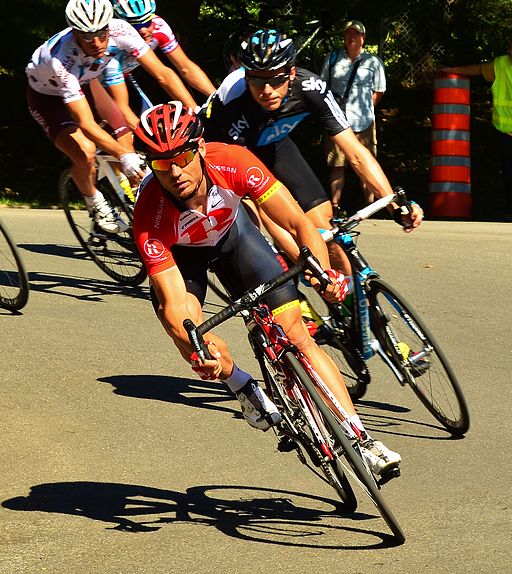| By Letartean (Own work) [CC-BY-3.0 (http://creativecommons.org/licenses/by/3.0)], via Wikimedia Commons |
Finding a good location to shoot a passing cycle race is a first consideration. Good images can be obtained most readily when the photographer has a clear view, an acceptable background, good light and some interesting action.
Images of the start of a race may be interesting because there is congestion and masses of colour and action. Zoom in close, and closer still, to convey the atmosphere. If you are fortunate enough to get a seat on a vehicle travelling with the cyclists, all sorts of opportunities will present themselves. However, most photographers do not have such opportunities.
Corners make interesting locations, particularly when the located on a rise with an uncluttered background, because the cyclists are banked over at an angle that helps to convey the impression of speed. Using a telephoto lens also tends to compress the field and give the impression that individual competitors are closer than they really were.
The use of fill-flash is important. The faces of the riders are unlikely to be all evenly lit, and some may have dark shadows in direct sunshine. To reduce the contrast and fill these shadows it is necessary to fill flash - even in bright daylight.
To freeze the action use a shutter speed of about 1/1,000 sec. If the light is poor, increase the ISO setting to make fast exposures possible. Alternatively, try panning the camera with the movement of the cyclists and using a much slower shutter speed - perhaps 1/50 sec or even slower. If the panning accurately follows the subject, the result should be a dynamic image with a reasonably sharp rider show against a blurred background. It does not matter that the wheels and pedals may be blurred.
Backgrounds are always important. Ideally, try to find a location where the peleton can be captured against a reasonably uniform area of greenery or, from a low viewpoint, perhaps against the sky. The riders will then pop out of the image if the aperture is chosen to render the background well out of focus. Try to avoid background distractions such as utility poles, buildings and parked cars even when they are out of focus. Background colour is also a factor. Bright white areas are distracting and elements of bright colours such as red, yellow and blue, also deflect the viewers eye from the subject.







